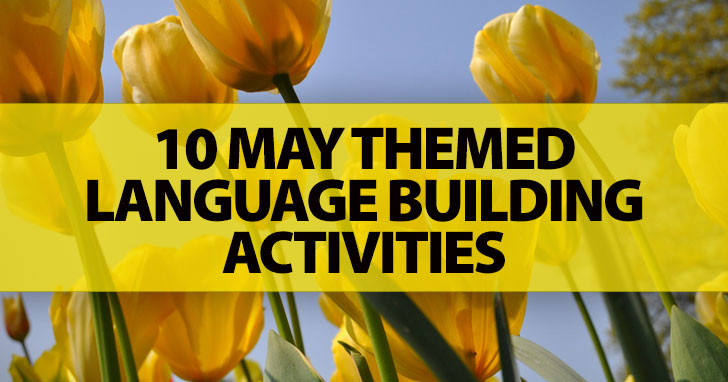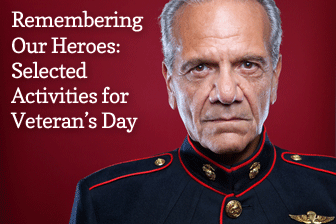10 May Themed Language Building Activities


Many men and women have given their time and their lives to fight for the freedom and safety of the ones they love and others they have never met.
On this day of remembrance and honor, take a closer look at what our countries and our veterans mean to all.
Veterans Among Us
If you are not new to teaching internationals, you will not be surprised to know that many of your students are military veterans. Many countries around the globe require their young men to serve a short amount of time in military service. Some nations require the same commitment from their young women. Break your class into groups of about four or five to discuss the topic of required military service. Does their home country require military service? Did they participate in it if their home country does require it? Encourage each person to share from his or her experience. Then have each group list as many advantages and disadvantages they can think of for mandatory military service. Close out the activity by asking each of your students to write a short opinion piece on whether they agree with or disagree with mandatory military service.
If you know someone who has served in the military and is willing to talk about his or her experiences, invite a veteran to your class to speak. He can share interesting stories from his time serving in the military, or he may want to talk about the type of training he went through to become a serviceman. Encourage your students to have some questions prepared to ask your speaker after his presentation. You can then encourage your students to write thank you notes to the speaker for sharing with your class.
Patriotism Reigns
What does it mean to be patriotic? Does it mean flying a national flag in front of your house or never questioning the government? Ask your students what they think it means to be patriotic. After that, list as many symbols of patriotism as you can think of. You should include items like the flag, and eagle, the White House and any others you and your class can think of and symbols that may be used in your students’ home countries. Then have each of your students choose one of these symbols from a country other than his own to research. How did it become a symbol of patriotism? What does it mean to people today? In what situation is it used? Ask your students to share this information in a poster that shows as well as explains the symbol. Then give each person a time in front of the class to share what he or she learned.
How many patriotic songs do your students know? Make a list of as many as you can think of, and then hand out the lyrics from the Star Spangled Banner. Do your students know the history of how those lyrics came about? If not, share with them the story of Francis Scott Key. Then give each student an opportunity to share his or her home country’s national anthem. Do they know the history of that song? If not, this is a good time to do some research. You may want to divide your class according to their home countries for group work. Then have each group share the information that they learned with the class. You can also create a bulletin board display with pictures and information from your students’ reports.
War Time Controversy
Your students can make some personal connections with a veteran of one of the most controversial military movements in U.S. history in this interview with a Vietnam veteran, recorded by Sharon Raynor. In the interview, John Luckey, an army photographer, brings up some controversial issues he encountered during his time in Vietnam. Perhaps the most significant controversy is the different treatment that black and white soldiers faced during and after the draft. Luckey states that at one point in the war, though African Americans made up only eight percent of the soldiers in that war, they accounted for twenty-three percent of the casualties. Though that statistic is not entirely accurate, it does reflect an attitude that was predominant among military leaders at that time. In your students’ opinions, should there be restrictions for applicants to military service? If so, what should they be? Should soldiers with certain conditions be assigned to more dangerous missions? Should race, age, sexual orientation or religion play any part in military service? Have each student make a list of the top ten restrictions he might impose on applicants to the military. These will probably include physical limitations as well as other criteria. Then group your students in threes or fours to share their lists of who they would restrict from military service. Was there any agreement between the lists? Was there any disagreement? If so, what were the points students could not agree upon? Have each student explain to his group why he chose the criteria he did and see if anyone has a change of opinion.
Saving Private Ryan
In this brutally realistic portrayal of war, a troop of soldiers sets out to save the life of the only remaining brother from a family of four. In so doing, members of the troop sacrifice their own lives in order to save the life of Private Ryan. This is just one example that shows how a man may sacrifice his own life for the lives of others. As your students remember the veterans who have served their countries, ask them to think about giving their lives for the life of another. Would they be willing to do that? If so, for whom would they be willing to die? In a free writing session, ask your students to take a stand on whether it is noble to give one’s life for another or whether it is too much to ask of anyone. Each student should take a position on the topic and then support it with specific examples, facts, personal experiences or experiences of others. Instead of or in addition to a time of writing, you can stage a class debate on the topic.
When Veteran’s Day brings to mind the sacrifices of men and women around the world, your students can be sure to give the due respect and remembrance to these soldiers.